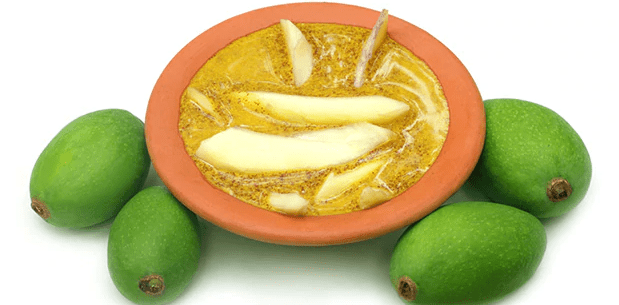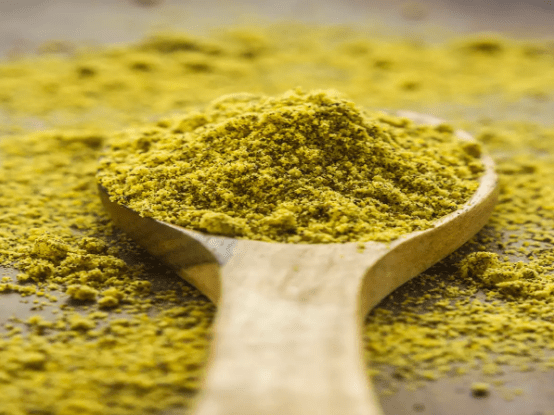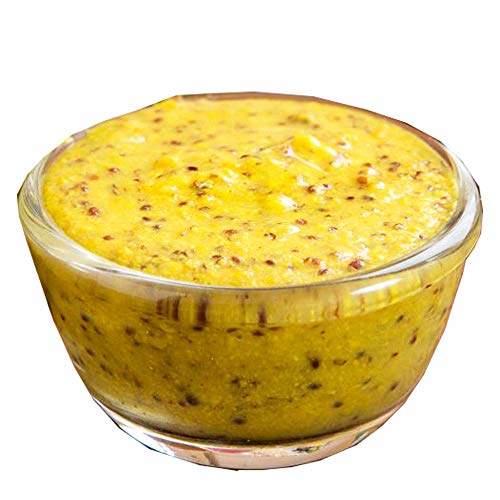About The Author
Hello! From Chuchura (in Hooghly District) and a foodie, I created this blog with a mission to preserve the food of the land; with a message to encourage and promote clean and real food. I hope you enjoy and gain out of this blog, happy reading!
Looking forward to read and hear your feedback.
Before I begin, here’s how to spell kasundi. KAA-SHOON-DHI!
If you have travelled the streets of Bengal and indulged yourself in the finger-licking variety of deliciousness that the region offers, you must have come across a golden and pungent ‘sauce’ as an accompaniment with chop, cutlet and fingers.
A fish cutlet or a mochar chop without the kasundi is an incomplete dish – it’s like the soul missing from the heart of the dish. Incidentally, this is not how kasundi started its journey as you will discover in this post.
Let me take the liberty to break another misconception that most Bengalis have – this grainy and fiery, mustard relish is not a sauce traditionally, but a pickle, a chutney!
Kasundi isn’t a sauce, it’s a pickle
~Food Fact
It’s an aachar, which also means ritual because a rigorous regimen had to be followed to prepare it.
Traditionally, the pleasantly sharp kasundi would be served at the beginning of the rice along with green chilies. You could also serve this with stir-fried greens.
Bengal’s Very Own Queen of Pickles
Kasundi was served with rice and green chili at the start of the meal. It acted like an appetizer. Even today, a dollop of kasundi with stir fried spinach or amaranth leaves and rice makes for the first course of the meal.
There’s a good reason why many culinary experts call kasundi as the queen of the pickles.
A spoonful of good-quality kasundi will lead to watery eyes and clear nasal congestion in seconds.
The making of kasundi was a royal affair – the entire process from segregation of mustard seeds to preparing the pickle was a ritualistic affair.
It was something that the royals (in the raj baris) and upper classes (zamindars) were extremely proud of and it was a closely held secret among the elite women who were also the only ones allowed to participate during the preparation process of it at home.
Only the upper class of the society participated in the process and was overseen by the priests.
This strict ritualistic practice ensured that the kasundi could be stored without refrigeration for 20 years.
FinallyFoodie.com
There is a reason why only the affluent sections of the society participated in making this pickle. Mustard was expensive in those days and only the rich could afford to invest both time and money to turn it into a pungent and tart pickle.
What Goes Into the Making of a Kasundi
There is no single and easy answer as every household had it’s own way of preparing the pungent pickle. The recipes were family secrets that were passed on to the next generation in hushed whispers.
The simplest method involved ingredients like mustard, turmeric and salt.
More complex methods used ingredients like powdered spices and even harvested fruits of the season like dried berries (jujube berry or kul) and mangoes. Sometimes, even a combination of fruits were used in making pickles. This included mango and tamarind, hog plum or amra and tamarind, kul and tamarind. The use of ginger is also noticeable.
4-Ingredient Kasundi
This is the minimalist version of the kasundi containing just 4 ingredients – dry mustard powder, water, salt and turmeric. Both black and yellow mustard seeds were used.
Gota Kasundi
Gota in Bengali translates to whole. This kasundi was dry in nature.
Whole spices would be washed, dried under the sun and powdered. This would be mixed with varieties of dry and ground fruits. Gota kasundi is ready for serving.
When a vegetarian dish was cooked, this mixture was sprinkled to enhance the flavor of the dish.
Jhal Kasundi and Aam Kasundi
Jhal in Bengali means fiery hot. This kasundi used more than 12 spices in minuscule and fixed proportions. The number of spices used would be an odd number, given the auspiciousness of odd number in Hindu rituals.
These spices include turmeric, cumin, coriander, dried red chilies, black pepper, bayleaf, fennel, cinnamon, nutmeg, mace, kebabchini, radhuni or wild celery seeds, nigella seeds, black and green cardamom.
Once this mixture of mustard powder and spices ferment, green mango paste is added. The raw green mango adds as the souring agent.

The use of spices in making kasundi is still prevalent today.
Phool Kasundi – Nothing to Waste
A traditional Bengali kitchen believes in the concept of ‘nothing goes to waste’.
During the preparation of kasundi, mustard is powdered and passed through a sieve. The coarse mixture left behind forms the primary ingredient for phool kasundi.
To the coarse residue, unripe mango, turmeric, salt and chilies are added to make a bolder and spicier pickle. This phool kasundi follows a similar process to that of any other kasundi.
One exception to the process was the participation of women in the entire process. Women were allowed to make this kasundi, from the beginning till the end.
Phool kasundi was used to prepare shukto and macher jhol.
The Kasundi Making Ritual
The making of the kasundi was considered as an important “stree achar” in the days of the zamindars and raj. As I have already mentioned, the goal was to achieve a high level of perfection ensuring complete hygiene and purity. The objective was to ensure that the quality and flavors of the kasundi remained intact across seasons – refrigerators were not available then.
Kasundi is now being commercially produced for only a few decades now. Earlier this was prepared at homes only and the recipe would be a closely guarded secret.
Food Fact
Ground Rules During the Kasundi Making Rituals
To ensure that the kasundi had a long shelf life, several customs were followed. Some of these are listed below.
- A family struck by tragedy would be prevented from participating further in the activity
- Preparing kasundi was prohibited in the month of birth or death in the family
- A family that failed to wash the mustard seeds would be barred from making the kasundi for the next 12 years
- Menstruating women and widows were not allowed to participate in the activity
- Initially, kasundi was served with vegetarian dishes only like mashed vegetables and stir fried greens. Kasundi with non-vegetarian dishes was a strict no-no
The Timing
Pickle making had to follow a certain chronology.
Kul (or jujube berry) went first. Tamarind followed kul. As the summers begin, raw mango would be harvested. Mustard followed and kasundi would be made.
The long and tedious process of making the kasundi always started on Akshay Tritiya, which falls between April and May. This comes right after mustard harvesting is done.
The timing is carefully chosen to ensure that the kasundi gets an optimal weather for fermentation – not too cold to delay the process, nor too humid to spoil the kasundi.
The Process of Making the Queen of Pickles
The making of kasundi at home was largely a three-step affair. And was carried out by specific members of the family.
Preparing the Mustard
Women of the household would form an odd-numbered group, take a bath and wear freshly washed, yet wet sarees.
The first step was preparing the seeds and spices. The women would segregate the mustard seeds manually before washing and cleaning it. There was no tap water then, and hence all the washing and cleaning would be done using river or pond water.
As the women washed and cleaned the seeds, they would sing mangal geet, and chanted for the wealth and well being of the family.
Tanushree Bhowmick recalls her grandmother telling her “…the mustard was brought back into the house accompanied by ululations, and after they were presented to the gods, ghee-filled lamps were lit. Five varieties of seasonal fruits, two unripe mangoes attached to one stem, betel leaf, betel nut, doob grass and paddy were offered too.”

Once the seeds are washed, they would be strained using a dhoti. The seeds would be kept under an open sun and left to dry completely.
These seeds were then hand pounded to make into a powder and sifted to remove any unwanted particles.
The women would also wash and clean the spices needed for the making of the kasundi, if needed.
The role of women ended here.
Mixing
In the early times, priests and baidyas (doctors) had a directly relationship with the eating habits of the society. Priests were considered to be masters in subjects like ayurveda.
Once the role of women ended with preparing the mustard powder, priests came in. The priest would keep the mustard powder in an earthen pot (that was also washed and dried).
He would add in water, salt,spices and oil based on the principles of ayurveda, for example. As he performed the process he would chant mantras.
You should note, however, that it was not mandatory to add mustard oil and sometimes the women folks were asked if they wanted to add any. Mustard oil was the choice of oil to enhance the flavor profile of the kasundi.
Fermentation
The pot would be covered with a muslin cloth and kept in the shade for two to three days to ferment. During the fermentation process, the mustard loses its bitterness to develop pungency.
The closest sauce to match the flavors of kasundi is the Japanese Wasabi
Food Fact
How to Consume Kasundi
Kasundi can be had in a myriad of ways, some of which are listed below.
- With stir fried greens – A dollop of kasundi with stir fried greens and rice helps break the monotony and tingles your taste buds
- As a dip with fried snacks – Be it fish roll, meat cutlet or a vegetarian chop, kasundi makes its presence felt
- Salad dressing
- Spice up the mashed potatoes – Does not matter how many ingredients you add to a mash potato, a spoon of this royal pickle gives it a twist
- As a marinade – Ever tried marinading your fish and meat with kasundi. Give it a try
- With Rice – Get a green chilly rubbed on some white rice, add a dollop of kasundi. Mix, eat, relish
Ending Notes
Steeped in history, customs, nostalgia and strict rituals, kasundi is in the truest sense, going back to the roots and feeling yourself at home.


The stories I heard from my mother are confirmed here in your article. And I got to learn a lot more.
Thank you,
Bashobi